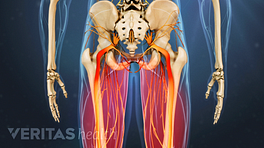Most cases of back or neck pain resolve within 2 to 6 weeks and are considered acute pain.
Most episodes of low back pain are caused by damage to the soft tissues supporting the lower spine.
Read Pulled Back Muscle and Lower Back Strain
The most common cause of acute back or neck pain is a muscle injury, in which muscle fibers stretch too far and tear. Muscle injury may be caused by overuse, such as from heavy lifting, as well as by repetitive motions that put continual stress on the back or neck muscles.
While a muscle injury may not sound like a serious issue, the resulting pain can be severe. Most muscle injuries alleviate within 6 weeks using treatments such as over-the-counter pain medicines, heat or ice therapy, or stretching exercises.
Common Causes of Chronic Back Pain
Underlying changes in the spine’s anatomy and mechanics are usually the cause of chronic low back pain.
The most common source of chronic back pain is a lumbar spinal disc—a sturdy, fibrous structure that acts as a ligament between vertebrae. A spinal disc can cause pain from:
- Lumbar disc herniation. A herniated disc occurs when the soft, gel-like interior of a disc bulges or leaks outward, irritating nearby muscles, joints, or nerve roots. A herniated disc typically causes sharp, stabbing pain down the backs of the legs (sciatica), which is usually more pronounced than low back pain.
- Lumbar degenerative disc disease. Wear-and-tear on the spinal discs that causes chronic low back pain is called lumbar degenerative disc disease. This condition typically causes chronic, low-level low back pain that intermittently flares up for a few days or weeks before returning to normal.
Other common causes of chronic back pain tend to stem from issues in the joints and vertebrae in the low back, including:
- Osteoarthritis. Spinal osteoarthritis consists of wear-and-tear on the facet joints, causing excess friction when twisting or bending the spine. This friction can lead to bone spurs that pinch a nerve root and produce sciatica pain. Other symptoms include stiffness and tenderness around the joint. Osteoarthritis is more common in adults over age 60.
- Sacroiliac joint dysfunction. The sacroiliac joint connects the hip bones (the ilia) to the sacrum, a triangular bone at the base of the spine. When the sacroiliac joint experiences too much or too little motion, it may cause pain in the hips, pelvis, and lower back.
- Isthmic spondylolisthesis. A spinal condition that occurs when one vertebral body slips forward over the vertebra below it, straining the disc and joints at the spinal segment. Slippage is caused by a fracture in back of the vertebrae. Low back pain, stiffness, and leg pain, numbness, and/or weakness are common symptoms of Isthmic spondylolisthesis .
- Spinal stenosis. Narrowing of the spinal canal due to a bone spur, herniated disc, or another irritant can cause leg pain (sciatica). While back pain may occur with spinal stenosis, it is usually not as severe as the leg pain caused by nerve root irritation. Spinal stenosis is more common in adults over age 60.
Health and lifestyle factors that increase the risk of developing back pain include activity that puts exorbitant stress on the spine, such as heavy lifting, sudden impact, or prolonged standing or sitting.
Smoking (or any nicotine intake), advanced age, and obesity are also risk factors for back pain.







